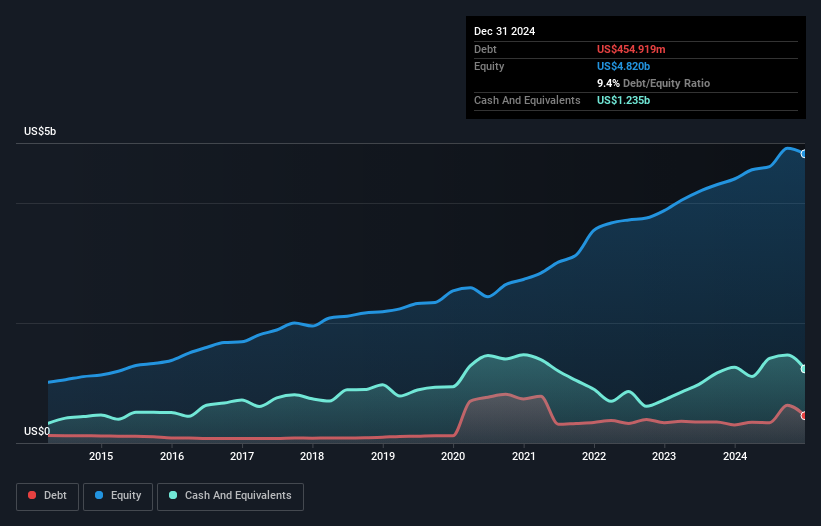Some say volatility, rather than debt, is the best way to think about risk as an investor, but Warren Buffett famously said that 'Volatility is far from synonymous with risk.' It's only natural to consider a company's balance sheet when you examine how risky it is, since debt is often involved when a business collapses. As with many other companies Skechers U.S.A., Inc. (NYSE:SKX) makes use of debt. But should shareholders be worried about its use of debt?
Why Does Debt Bring Risk?
Debt and other liabilities become risky for a business when it cannot easily fulfill those obligations, either with free cash flow or by raising capital at an attractive price. Part and parcel of capitalism is the process of 'creative destruction' where failed businesses are mercilessly liquidated by their bankers. However, a more common (but still painful) scenario is that it has to raise new equity capital at a low price, thus permanently diluting shareholders. By replacing dilution, though, debt can be an extremely good tool for businesses that need capital to invest in growth at high rates of return. When we think about a company's use of debt, we first look at cash and debt together.
View our latest analysis for Skechers U.S.A
How Much Debt Does Skechers U.S.A Carry?
You can click the graphic below for the historical numbers, but it shows that as of December 2024 Skechers U.S.A had US$454.9m of debt, an increase on US$301.4m, over one year. But on the other hand it also has US$1.23b in cash, leading to a US$780.1m net cash position.

A Look At Skechers U.S.A's Liabilities
According to the last reported balance sheet, Skechers U.S.A had liabilities of US$2.26b due within 12 months, and liabilities of US$1.38b due beyond 12 months. Offsetting this, it had US$1.23b in cash and US$1.09b in receivables that were due within 12 months. So its liabilities total US$1.31b more than the combination of its cash and short-term receivables.
Of course, Skechers U.S.A has a market capitalization of US$8.44b, so these liabilities are probably manageable. Having said that, it's clear that we should continue to monitor its balance sheet, lest it change for the worse. Despite its noteworthy liabilities, Skechers U.S.A boasts net cash, so it's fair to say it does not have a heavy debt load!
And we also note warmly that Skechers U.S.A grew its EBIT by 15% last year, making its debt load easier to handle. There's no doubt that we learn most about debt from the balance sheet. But ultimately the future profitability of the business will decide if Skechers U.S.A can strengthen its balance sheet over time. So if you want to see what the professionals think, you might find this free report on analyst profit forecasts to be interesting.
But our final consideration is also important, because a company cannot pay debt with paper profits; it needs cold hard cash. Skechers U.S.A may have net cash on the balance sheet, but it is still interesting to look at how well the business converts its earnings before interest and tax (EBIT) to free cash flow, because that will influence both its need for, and its capacity to manage debt. In the last three years, Skechers U.S.A's free cash flow amounted to 47% of its EBIT, less than we'd expect. That's not great, when it comes to paying down debt.
Summing Up
Although Skechers U.S.A's balance sheet isn't particularly strong, due to the total liabilities, it is clearly positive to see that it has net cash of US$780.1m. On top of that, it increased its EBIT by 15% in the last twelve months. So we don't have any problem with Skechers U.S.A's use of debt. The balance sheet is clearly the area to focus on when you are analysing debt. However, not all investment risk resides within the balance sheet - far from it. To that end, you should be aware of the 1 warning sign we've spotted with Skechers U.S.A .
At the end of the day, it's often better to focus on companies that are free from net debt. You can access our special list of such companies (all with a track record of profit growth). It's free.
New: Manage All Your Stock Portfolios in One Place
We've created the ultimate portfolio companion for stock investors, and it's free.
• Connect an unlimited number of Portfolios and see your total in one currency
• Be alerted to new Warning Signs or Risks via email or mobile
• Track the Fair Value of your stocks
Have feedback on this article? Concerned about the content? Get in touch with us directly. Alternatively, email editorial-team (at) simplywallst.com.
This article by Simply Wall St is general in nature. We provide commentary based on historical data and analyst forecasts only using an unbiased methodology and our articles are not intended to be financial advice. It does not constitute a recommendation to buy or sell any stock, and does not take account of your objectives, or your financial situation. We aim to bring you long-term focused analysis driven by fundamental data. Note that our analysis may not factor in the latest price-sensitive company announcements or qualitative material. Simply Wall St has no position in any stocks mentioned.
About NYSE:SKX
Skechers U.S.A
Designs, develops, and markets footwear, apparel, and accessories worldwide.
Undervalued with excellent balance sheet.
Similar Companies
Market Insights
Community Narratives





